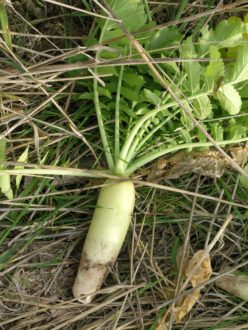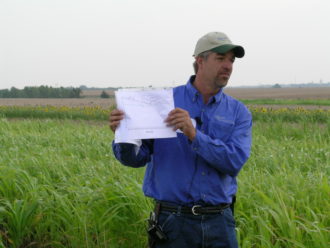Every drop of water counts for farmers who practice dryland cultivation, a practice that relies on rainfall without the benefit of irrigation. So, when it comes to incorporating cover crops into a dryland rotation, many farmers hesitate, wondering: “How much moisture is the cover crop going to demand, and will I pay for it later in lost cash-crop yields?”
This is the “first question and major concern any dryland farmer has about cover crops,” says Bladen, Neb., farmer Keith Berns. But thanks to SARE-funded research he and his brother conducted on their 2,000-acre farm—about two-thirds of it dryland—they now have an answer to share with their peers.
Keith and Brian Berns found that, in fact, cover crops can significantly boost corn yields in a non-irrigated setting. In one trial, they planted corn after a cover crop mix of grasses, legumes and brassicas, and saw a corn yield that was about 10 percent better than planting straight into wheat stubble.
“The results of this project have made us firm believers in cover crops,” says Keith Berns, who raises corn, soybeans and wheat, and has been practicing full continuous no-till for 12 years.
In their trials, conducted in 2008 and 2009, the Bernses tested cover-crop monocultures as well as mixes—including sunflowers, soybeans and oilseed radish—but found that mixes were the best performers, in part because they were the most frugal with water. Although a wet season skewed some of their moisture data collection, they found that the cover-crop mixes used far less water than the cover-crop monocultures, and were on par with water use in wheat stubble alone.
They acknowledge that they are not done exploring cover crops. “We will continue to experiment with different mixes, seeding rates and plant species,” says Keith. “We also hope to continue to monitor water usage of cover crops, and also measure yield in the crop following our cover crops.”
Additionally, they are experimenting with putting livestock on cover crops—looking at grazing intensities, regrowth periods and nutritional quality.
In the meantime, the brothers are busy spreading the word about their findings and helping others adopt cover crops. During the course of their SARE research, they hosted two on-farm field days and spoke at nearly 25 public events, to a total of about 1,500 people. They also host an annual one-day cover-crop school in Bladen.
The SARE grant has yielded even more benefits: The Berns brothers have launched a new cover-crop seed business, and now maintain a website—www.greencoverseed.com—that contains practical information on their research. A highlight is their SmartMix Calculator, an online spreadsheet that calculates seed quantities and cost, carbon-to-nitrogen ratio (C:N), nitrogen-fixation potential and other factors for mixes of nearly 40 cover-crop species, including legumes, brassicas, grasses and broadleaf crops.

